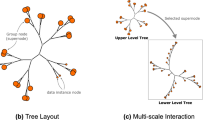Summary
An increasingly important problem in exploratory data analysis and visualization is that of scale; more and more data sets are much too large to analyze using traditional techniques, either in terms of the number of variables or the number of records. One approach to addressing this problem is the development and use of multiresolution strategies, where we represent the data at different levels of abstraction or detail through aggregation and summarization. In this paper we present an overview of our recent and current activities in the development of a multiresolution exploratory visualization environment for large-scale multivariate data. We have developed visualization, interaction, and data management techniques for effectively dealing with data sets that contain millions of records and/or hundreds of dimensions, and propose methods for applying similar approaches to extend the system to handle nominal as well as ordinal data.






Similar content being viewed by others
References
D. Brodbeck, M. Chalmers, A. Lunzer, and P. Cotture, Domesticating bead: Adapting an information visualization system to a financial institution., Proc. Information Visualization 97, pp. 73–80, 1997.
Y. Fua, M. O. Ward, and E. A. Rundensteiner, Hierarchical parallel coordinates for visualizing large multivariate data sets, Proc. Visualization 99, pp. 43–50, October, 1999.
Y. Fua, M. O. Ward, and E. A. Rundensteiner, Navigating hierarchies with structure-based brushes, Proc. Information Visualization 99, pp. 58–64, October, 1999.
Y. Fua, M. O. Ward, and E. A. Rundensteiner, Structure-based brushes: a mechanism for navigating hierarchically organized data and information spaces, IEEE Trans. Visualization and Computer Graphics, V. 6, pp. 150–159, 2000.
J. Jolliffe. Principal Component Analysis. Springer Verlag, 1986.
S. Kaski, Dimensionality reduction by random mapping: Fast similarity computation for clustering, Proc. IJCNN, p. 413–418, 1998.
D. Keim, H. Kriegel, and M. Ankerst, Recursive pattern: a technique for visualizing very large amounts of data, Proc. of Visualization 95, p. 279–86, 1995.
T. Kohonen. Self Organizing Maps. Springer Verlag, 1995.
A. Mead, Review of the development of multidimensional scaling methods, The Statistician, Vol. 33, p. 27–35, 1992.
B. Shneiderman, Tree visualization with tree-maps: A 2d space-filling approach, ACM Transactions on Graphics, Vol. 11(1), p. 92–99, Jan. 1992.
D. Stroe, E. A. Rundensteiner, and M. O. Ward, Scalable visual hierarchy exploration, Proc. DEXA 2000, September, 2000.
M. O. Ward, XmdvTool: integrating multiple methods for visualizing multivariate data. Proc. Visualization 94, pp. 326–333, October, 1994.
M. O. Ward and A. R. Martin, High dimensional brushing for interactive exploration of multivariate data. Proc. Visualization 95, pp. 271–278, 1995.
M. O. Ward, Creating and manipulating N-dimensional brushes, Proc. Joint Statistical Meeting, pp. 6–14, August, 1997.
M. O. Ward, Y. Jing, and E. A. Rundensteiner, Hierarchical exploration of large multivariate data spaces, Proc. Dagstuhl Seminar on Scientific Visualization, May, 2000.
G. Wills, An interactive view for hierarchical clustering, Proc. Information Visualization 98, p. 26–31, 1998.
J. A. Wise, J. J. Thomas, K. Pennock, D. Lantrip, M. Pottier, A. Schur, and V. Crow, Visualizing the non-visual: Spatial analysis and interaction with information from text documents, Proc. Information Visualization 95, pp. 51–58, 1995.
J. A. Wise, The ecological approach to text visualization, JASIS, Vol. 50, No. 13, p. 1224–1233, 1999.
E. Wegman and Q. Luo, High dimensional clustering using parallel coordinates and the grand tour, Computing Science and Statistics, Vol. 28, p. 361–8, 1997.
P. Wong and R. Bergeron, Multiresolution multidimensional wavelet brushing, Proc. Visualization 96, p. 141–8, 1996.
J. Yang, M. Ward, and E. Rundensteiner, Interactive hierarchical displays: a general framework for visualization and exploration of large multivariate data sets, Computers and Graphics, in press.
J. Yang, M. Ward, and E. Rundensteiner, Interring: a radial, spacefilling hierarchy visualization system with a set of navigation, modification, and selection tools, IEEE Symposium on Information Visualization (InfoVis 02), pp. 77–84, 2002.
J. Yang, M. O. Ward and E. A. Rundensteiner, “Visual hierarchical dimension reduction for exploration of high dimensional datasets, Technical Report #WPI-CS-TR-02-22, 2002.
J. York, S. Bohn, K. Pennock, and D. Lantrip, Clustering and dimensionality reduction in Spire. Proc. Symposium on Advanced Intelligence Processing and Analysis, p. 73, 1995.
Acknowledgements
This work has been supported by U.S. National Science Foundation under grants IIS-9732897, IIS-0119276, and EIA-9729878.
Author information
Authors and Affiliations
Rights and permissions
About this article
Cite this article
Ward, M., Peng, W. & Wang, X. Hierarchical visual data mining for large-scale data. Computational Statistics 19, 147–158 (2004). https://doi.org/10.1007/BF02915281
Published:
Issue Date:
DOI: https://doi.org/10.1007/BF02915281




